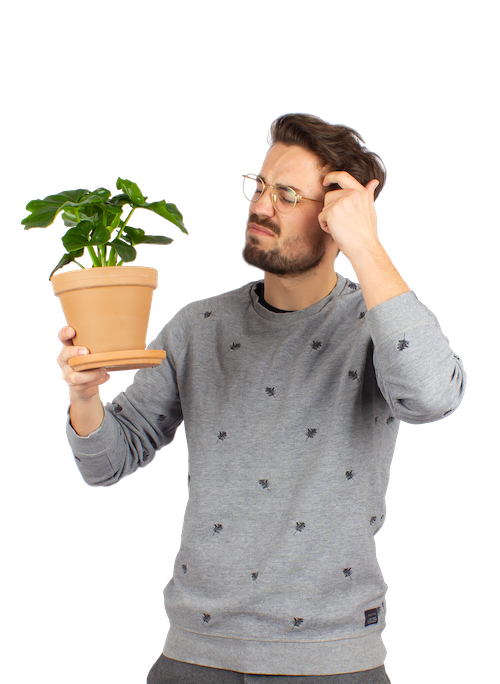Re-potting can be a pesky task that all of us plant parents are guilty for “saving for a rainy day”. And maybe rightly so! Spring and summer are growing seasons for your green amigos, so waiting out the winter to re-pot may not be such a bad idea.
The ins and outs of repotting can be quite confusing, so we put together a repotting guide that breaks down all the info you need including when to repot, why you should repot, and a step-by-step guide on how to repot your green amigos! Let’s get digging, shall we?

When to repot:
There are a couple key signs to look for in your plants that will tell you when it’s time to repot. These green amigos are smarter than they lead on! 😉 Look for for these telltale signs...
- Repot when... you see roots poking out of the top layer of soil.
- Repot when… the roots start coming out from underneath the pot/outgrowing their nursery pot.
- Repot when… you see that your green amigo could be ill (wilting, fuzzy grey mold, yellowing or discolored leaves)
- Repot when...you see that your plant is clearly reaching the edges of its pot!
Why you should repot your plants (when the timing is right, of course):
- Your green friend will have more room to grow and thrive!
- Fresh potting soil provides fresh nutrients, which stimulates growth.
- Adding soil provides your plant with a larger reservoir of stored water (which means you can expect to water less frequently!)
- Prevents roots from choking inside the pot from not being able to reach the nutrients they need.
- Reduces the likelihood of disease.
Some other things to keep in mind before you decide to re-pot:
Re-potting your plant after purchase
Whether or not you choose to purchase a new pot with your plant, all Plantsome plants come in their original grower's pot! Your new green friend will be happy in their growers pot for many months, but eventually you will need to move them into a new home. All growers pots have large drainage holes that allow excess water to flow out.

Repotting Plants into pots with drainage
If you bought a pot that has proper drainage holes, you've got it easy! You can re-pot your plant right away. All excess water will simply flow away, plus you are minimizing the risk of root rot from standing water.
Quick Tip: To make sure your floor doesn't get soaked, make sure you have a saucer or flood tray so the water can flow out without damaging your floor. If you’re not a fan of that look, keep that in mind before you order your pots!
Repotting plants without drainage
If you’re not the type to sacrifice style for practicality, pots without drainage gives you more flexibility in terms of shapes and sizes of pots. However, because the water has no place to go, you will have to add a layer of drainage to the bottom of the pot and train yourself not to over-water your plant. Alternatively, you can repot into a larger nursery pot, and simply remove the nursery pot from the decorative pot when it’s time to water.
If you choose to add a layer of drainage to the bottom of your decorative pot, there are many materials to choose from including; clay shards, wood chips, small pebbles, rocks or even charcoal. This layer of drainage prevents your green amigo’s roots from sitting in pooled water, which could eventually lead to root rot.

Re-potting an older plant
Your green amigos likes being re-potted about once every two years, especially the fast growers who may prefer a yearly ritual!
Repot your plant in these 7 easy steps!
Now that we’ve explored when to re-pot, the benefits of re-potting and the different styles of pots, let’s dive straight into the process of how to re-pot your plants and put this plan into action! In just 7 relatively simple steps, your green amigo will be happy (and thriving) in it’s new home.
- Water your plant a day or two before re-potting your plant. The soil and roots should be nice and hydrated to reduce the risk of shock in its new environment.
- If your pot has no drainage hole add a 2 cm layer of gravel to the bottom of the pot, this will help your plant's roots breathe.
- Add soil to the pot. Add enough soil to the pot so that when transferred, the base of the plant is about 1-2 cm below the rim of the pot.
- Remove the plant from its old pot. When you do this, be careful that you don't pull the plant. Instead, tip the plant upside down with one hand covering the soil and then with your other hand gently loosen and lift the pot.
- Place the plant in the new pot, gently shaking the old soil to loosen up the roots. Centre the plant and ensure that the base of the plant is 1-2 cm below the rim of the pot.
- Add more soil around the sides of the root ball. With your fingers, gently pack down the soil on all sides until the plant is firmly positioned.
- Water your plant one more time. Add more soil if necessary but be sure to not cover the base or stem of the plant with soil.
Well, what are you waiting for - time to give your green friend a new home!
If you have any questions about re-potting your plants, or unsure where to start email hello@plantsome.ca or follow us on Instagram and Facebook for more tips and tricks in caring for your plants.





